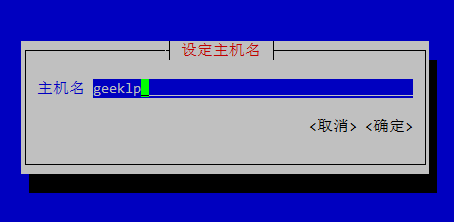Linux系统常用知识(centos7)
一、查看系统版本
1、查看linux内核版本
#cat /etc/redhat-release
二、主机名
2.1定义:
静态的(Static hostname):“静态”主机名也称为内核主机名,是系统在启动时从/etc/hostname自动初始化的主机名
瞬态的(Tansient hostname):“瞬态”主机名是在系统运行时临时分配的主机名,例如,通过DHCP或mDNS服务器分配。
灵活的(Pretty hostname):
“灵活”主机名也有人叫做“别名”主机名。
“灵活”主机名则允许使用自由形式(包括特殊/空白字符)的主机名,以展示给终端用户(如xh01@f5)。
“静态”主机名和“瞬态”主机名都遵从作为互联网域名同样的字符限制规则。
2.2查看主机名
2.2.1查看到的是瞬态的(Tansient hostname)
#hostname
2.2.2查看主机名配置文件,查看到的是静态的(Static hostname)
#cat /etc/hostname
2.2.3只查看静态、瞬态或灵活主机名,分别使用--static,--transient或--pretty选项
.hostnamectl --static //静态
.hostnamectl --transient //瞬态
.hostnamectl --pretty //灵活主机名
2.3.4修改主机名
(1)临时修改
#hostname xxx //lzw为新的主机名
(2)永久修改
- 方法一:
#hostnamectl set-hostname xxx
- 方法二:
#vim /etc/hostname
#编辑模式,输入新的主机名即可
- 方法三:
通过nmtui修改,之后重启hostnamed
#nmcli general hostname servername #systemctl restart systemd-hostnamed
还可以通过nmtui进入图形界面来修改主机名。将光标通过键盘的上下键移动到“设定系统主机名”菜单处,按下回车键。

此时,屏幕出现“设定主机名”选项卡,输入需要设定的主机名,通过键盘方向键将光标移动到“确定”处,回车键确定即可完成主机名的修改。

三、设置网络信息
1、进入网卡
#cd /etc/sysconfig/network-scripts
#ls
#vim eth0

2、设置网络
四、设置dns解析
1、本地解析
#vim /etc/hosts

2、设置DNS服务器
#vim /etc/resolv.conf

五、Centos7中systemctl的使用
CentOS 7.x开始,CentOS开始使用systemd服务来代替daemon,原来管理系统启动和管理系统服务的相关命令全部由systemctl命令来代替。
1、原来的 service 命令与 systemctl 命令对比
| daemon命令 | systemctl命令 | 说明 |
|---|---|---|
| service [服务] start | systemctl start [unit type] | 启动服务 |
| service [服务] stop | systemctl stop [unit type] | 停止服务 |
| service [服务] restart | systemctl restart [unit type] | 重启服务 |
此外还是二个systemctl参数没有与service命令参数对应
- status:参数来查看服务运行情况
- reload:重新加载服务,加载更新后的配置文件(并不是所有服务都支持这个参数,比如network.service)
应用举例:
#启动网络服务
systemctl start network.service
#停止网络服务
systemctl stop network.service
#重启网络服务
systemctl restart network.service
#查看网络服务状态
systemctl status network.serivce
2、原来的chkconfig 命令与 systemctl 命令对比
2.1、设置开机启动/不启动
| daemon命令 | systemctl命令 | 说明 |
|---|---|---|
| chkconfig [服务] on | systemctl enable [unit type] | 设置服务开机启动 |
| chkconfig [服务] off | systemctl disable [unit type] | 设备服务禁止开机启动 |
应用举例:
#停止cup电源管理服务
systemctl stop cups.service
#禁止cups服务开机启动
systemctl disable cups.service
#查看cups服务状态
systemctl status cups.service
#重新设置cups服务开机启动
systemctl enable cups.service2.2、查看系统上上所有的服务
命令格式:
systemctl [command] [–type=TYPE] [–all]
参数详解:
command - list-units:依据unit列出所有启动的unit。加上 –all 才会列出没启动的unit; - list-unit-files:依据/usr/lib/systemd/system/ 内的启动文件,列出启动文件列表
–type=TYPE - 为unit type, 主要有service, socket, target
应用举例:
| systemctl命令 | 说明 |
|---|---|
| systemctl | 列出所有的系统服务 |
| systemctl list-units | 列出所有启动unit |
| systemctl list-unit-files | 列出所有启动文件 |
| systemctl list-units –type=service –all | 列出所有service类型的unit |
| systemctl list-units –type=service –all grep cpu | 列出 cpu电源管理机制的服务 |
| systemctl list-units –type=target –all | 列出所有target |
3、systemctl特殊的用法
| systemctl命令 | 说明 |
|---|---|
| systemctl is-active [unit type] | 查看服务是否运行 |
| systemctl is-enable [unit type] | 查看服务是否设置为开机启动 |
| systemctl mask [unit type] | 注销指定服务 |
| systemctl unmask [unit type] | 取消注销指定服务 |
应用举例:
#查看网络服务是否启动
systemctl is-active network.service
#检查网络服务是否设置为开机启动
systemctl is-enable network.service
#停止cups服务
systemctl stop cups.service
#注销cups服务
systemctl mask cups.service
#查看cups服务状态
systemctl status cups.service
#取消注销cups服务
systemctl unmask cups.service4、init 命令与systemctl命令对比
| init命令 | systemctl命令 | 说明 |
|---|---|---|
| init 0 | systemctl poweroff | 系统关机 |
| init 6 | systemctl reboot | 重新启动 |
与开关机相关的其他命令:
| systemctl命令 | 说明 |
|---|---|
| systemctl suspend | 进入睡眠模式 |
| systemctl hibernate | 进入休眠模式 |
| systemctl rescue | 强制进入救援模式 |
| systemctl emergency | 强制进入紧急救援模式 |
5、设置系统运行级别
5.1、运行级别对应表
| init级别 | systemctl target |
|---|---|
| 0 | shutdown.target |
| 1 | emergency.target |
| 2 | rescure.target |
| 3 | multi-user.target |
| 4 | 无 |
| 5 | graphical.target |
| 6 | 无 |
此外还是一个getty.target用来设置tty的数量。
5.2、设置运行级别
命令格式:
systemctl [command] [unit.target]
参数详解:
command:
- get-default :取得当前的target
- set-default :设置指定的target为默认的运行级别
- isolate :切换到指定的运行级别
- unit.target :为5.1表中列出的运行级别
| systemctl命令 | 说明 |
|---|---|
| systemctl get-default | 获得当前的运行级别 |
| systemctl set-default multi-user.target | 设置默认的运行级别为mulit-user |
| systemctl isolate multi-user.target | 在不重启的情况下,切换到运行级别mulit-user下 |
| systemctl isolate graphical.target | 在不重启的情况下,切换到图形界面下 |
6、使用systemctl分析各服务之前的依赖关系
命令格式:
systemctl list-dependencies [unit] [–reverse]
–reverse是用来检查寻哪个unit使用了这个unit
应用举例:
#获得当前运行级别的target
[root@www ~]# systemctl get-default
multi-user.target
#查看当前运行级别target(mult-user)启动了哪些服务
[root@www ~]# systemctl list-dependencies
default.target
├─abrt-ccpp.service
├─abrt-oops.service
├─vsftpd.service
├─basic.target
│ ├─alsa-restore.service
│ ├─alsa-state.service
.....(中间省略).....
│ ├─sockets.target
│ │ ├─avahi-daemon.socket
│ │ ├─dbus.socket
.....(中间省略).....
│ ├─sysinit.target
│ │ ├─dev-hugepages.mount
│ │ ├─dev-mqueue.mount
.....(中间省略).....
│ └─timers.target
│ └─systemd-tmpfiles-clean.timer
├─getty.target
│ └─getty@tty1.service
└─remote-fs.target
#查看哪些target引用了当前运行级别的target
[root@www ~]# systemctl list-dependencies --reverse
default.target
└─graphical.target7、关闭网络服务
在使用systemctl关闭网络服务时有一些特殊 需要同时关闭unit.servce和unit.socket
使用systemctl查看开启的sshd服务
[root@www system]# systemctl list-units --all | grep sshd
sshd-keygen.service loaded inactive dead OpenSSH Server Key Generation
sshd.service loaded active running OpenSSH server daemon
sshd.socket loaded inactive dead OpenSSH Server Socket
可以看到系统同时开启了 sshd.service 和 sshd.socket , 如果只闭关了 sshd.service 那么 sshd.socket还在监听网络,在网络上有要求连接 sshd 时就会启动 sshd.service 。因此如果想完全关闭sshd服务的话,需要同时停用 sshd.service 和 sshd.socket 。
systemctl stop sshd.service
systemctl stop sshd.socket
systemctl disable sshd.service sshd.socket
由于centos 7.x默认没有安装net-tools,因此无法使用netstat 来查看主机开发的商品。需要通过yum安装来获得该工具包:
yum -y install net-tools
查看是否关闭22端口
netstat -lnp |grep sshd
8、关闭防火墙firewall
Centos 7.x 中取消了iptables, 用firewall取而代之。要关闭防火墙并禁止开机启动服务使用下面的命令:
systemctl stop firewalld.service
systemctl disable firewalld.serviceLinux系统常用知识(centos7)的更多相关文章
- Linux 学习手记(4):Linux系统常用Shell命令
日期时间 date命令:显示当前时间日期 date -u # 显示格林威治(UTC)事件 date +%Y-%m-%d # 格式显示日期 date -s '20:25:25' # 修改系统时间,需要使 ...
- Linux系统常用升级的基础包
Linux系统常用升级的基础包 yum -y install lrzsz gcc gcc-c++ make flex autoconf automake vixie-cron libjpeg libj ...
- linux系统常用的基本命令分类
linux系统常用的基本命令分类: 文件命令:vim vimdiff diff mkdir touch rm mv cp ln cd ls more less head tail cat grep e ...
- 9个Linux系统常用监控命令
我们的系统一旦上线跑起来我们自然希望它一直相安无事,不要宕机,不要无响应,不要慢腾腾的.但是这不是打开机器电源然后放任不管就可以得到的.所以我们要监视系统的运行状况,发现问题及时处理. 对于系统和网络 ...
- linux linux系统常用设置
linux linux系统常用设置 一.设置开机时开启数字键 修改rc.local文件 命令:vi /etc/rc.local rc.local文件中增加如下代码: INITTY=/dev/tty ...
- 一文详解 Linux 系统常用监控工一文详解 Linux 系统常用监控工具(top,htop,iotop,iftop)具(top,htop,iotop,iftop)
一文详解 Linux 系统常用监控工具(top,htop,iotop,iftop) 概 述 本文主要记录一下 Linux 系统上一些常用的系统监控工具,非常好用.正所谓磨刀不误砍柴工,花点时间 ...
- Linux系统基础知识整理
一.说明 本篇文章,我将结合自己的实践以及简介,来对linux系统做一个直观清晰的介绍,使得哪些刚接触Linux的小伙伴可以快速入门,也方便自己以后进行复习查阅. 二.基本知识整理 1.Linux文件 ...
- Linux系统基础知识整理(一)
本文来自于: https://www.cnblogs.com/hafiz/p/6686187.html#4196989 一.说明 本篇文章,我将结合自己的实践以及简介,来对linux系统做一个直观清晰 ...
- Linux 系统常用管理命令(精简笔记)
Linux是一套免费使用和自由传播的类Unix操作系统,下面的笔记是我从鸟菜中摘抄出来的重要命令,并进行了一定的排版,摒弃了一些用不到的乱七八糟的命令,目的是在生产环境中能够快速的定位并查询需要命令的 ...
随机推荐
- win7系统安装sql2000数据库时没有反应,不出来安装界面?
今天一个客户反馈软件连不上数据库,经检查发现SQL服务启动不了,懒得查原因就把SQL2000卸载了,他们电脑是win7的系统,本来正常来说安装SQL2000数据库是没啥问题的,可是特别奇怪的是,这台w ...
- php strrchr()函数 语法
php strrchr()函数 语法 作用:返回一个字符串在另一个字符串中最后一次出现的位置,并返回从该位置到字符串结尾的所有字符.大理石平台哪家好 语法:strrchr(string,char) 参 ...
- FastDFS介绍(一)
1.简介 FastDFS对文件进行管理,功能包括:文件存储.文件同步.文件访问(文件上传.文件下载.文件删除)等,解决了大容量文件存储的问题,特别适合以文件为载体的在线服务,如相册网站.文档网站.图片 ...
- codecs模块, decode、encode
使用codecs模块,在Python中完成字符编码 字符的编码是按照某种规则在单字节字符和多字节字符之间进行转换的某种方法.从单字节到多字节叫做decoding,从多字节到单字节叫做encodin ...
- ruby异常处理
begin # 这段代码抛出的异常将被下面的 rescue 子句捕获 rescue # 这个块将捕获所有类型的异常 retry # 这将把控制移到 begin 的开头 end
- JS对象—对象总结(创建、属性、方法)
1.创建对象Object 1.1 字面量的方式创建 1.2 new Object() 1.3 构造函数创建 1.4 工厂模式 1.5 Object.create() ES5新增方法 Object. ...
- Eclipse如何汉化[完美版]
当前版本:Eclipse 4.5.1 1.如何查看eclipse的版本呢 找到关于Eclipse,点击 . 2.打开浏览器连接http://www.eclipse.org/babel/download ...
- HTML/CSS点滴记录
1. overflow 定义溢出元素内容区的内容会如何处理 visible 默认值.内容不会被修剪,会呈现在元素框之外. hidden 内容会被修剪,并且其余内容是不可见的. scroll 内容会被修 ...
- xmake 描述语法和作用域详解
xmake的工程描述文件xmake.lua虽然基于lua语法,但是为了使得更加方便简洁得编写项目构建逻辑,xmake对其进行了一层封装,使得编写xmake.lua不会像些makefile那样繁琐 基本 ...
- jQuery基础--jQuery特殊属性操作
1.index() 会返回当前元素在所有兄弟元素里面的索引. <!DOCTYPE html> <html lang="zh-CN"> <head> ...
